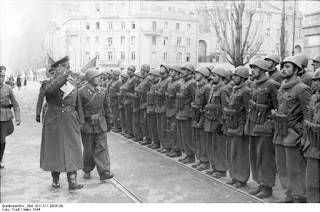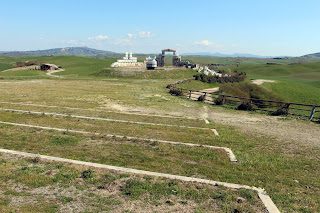Deposed dictator proclaims Republic of Salò
 |
| A Luftwaffe general inspects soldiers of the Italian Social Republic in Rome in 1943 |
The establishment of this new state with the Fascist dictator as its leader was announced just 11 days after German special forces freed Mussolini from house arrest in the Apennine mountains.
Although Mussolini was said to be in failing health and had hoped to slip quietly into the shadows after his escape, Hitler's compassion for his Italian ally - whose rescue had been on the direct orders of the Fuhrer - did not extend to giving him an easy route into retirement.
Faced with an Allied advance along the Italian peninsula that was gathering momentum, he put Mussolini in charge of the area of northern and central Italy of which the German army had taken control following the Grand Fascist Council's overthrow of the dictator.
Although the area was renamed the Italian Social Republic - also known as the Republic of Salò after the town on the shores of Lake Garda where Mussolini's new government was headquartered - it was essentially a puppet German state. Only Germany and its other ally, Japan, recognised it as legitimate.
 |
| Mussolini and Hitler in Munich with Ciano second left in the picture |
These included his son-in-law, Count Galeazzo Ciano, his former Foreign Minister, who had fled to Germany after Mussolini's reinstatement only to be sent back on Hitler's orders. Mussolini's daughter, Edda, pleaded with her father for Ciano to be spared but she was ignored. Ciano and five others were executed by firing squad.
Although Mussolini was theoretically head of his own Italian army, which numbered about 150,000 personnel, decisions were taken in Germany, among them an order to carry out mass executions of Italian citizens in revenge for attacks on German soldiers by the Italian resistance. One such attack in March 1944 triggered the slaughter of 335 Italians in retaliation for a bomb attack that killed 33 German soldiers. Mussolini was powerless to prevent the massacre of his own citizens, which hardly helped his popularity.
Meanwhile, the Allied advanced steadily forced the German army into retreat and by April 1945 the end for Mussolini and his Italian Social Republic was becoming inevitable. In his public speeches, Mussolini was defiant, urging his people to ‘fight to the last Italian’. Secretly, however, he was plotting his escape.
On April 25, accompanied by a few fellow Fascists who still supported him, he and his mistress, Claretta Petacci, fled Salò, hoping to reach neutral Switzerland. His wife, Rachele, was left behind in Salò. He had been on the run for only a day, however, when he was recognised at a checkpoint set up by Italian partisans on the shores of Lake Como and captured.
Two days later, Mussolini, Petacci and the rest of his entourage were executed, after which their bodies were taken to Milan and suspended for public display from a beam above a petrol station.
Travel tip:
For all its regrettable association with such a despised figure as Mussolini, Salò has recovered to become a pleasant resort on the shore of Lake Garda, visited by many tourists each year. Its promenade is the longest of any of the lakeside towns and it has a Duomo rebuilt in Gothic style in the 15th century as well as a museum commemorating, among other things, the resistance against Fascism.
 |
| Piazzale Loreto in Milan today, a square bearing little resemblance to how it looked in 1945 |
Visitors to Milan hoping to find the scene of Mussolini's final humiliation, when his body and those of his mistress and accomplices were hung upside down from a beam across an Esso petrol station, will find little evidence that the event took place. Piazzale Loreto, the location of the Esso station, was renamed Piazza Quindici Martiri in honour of 15 Italian partisans murdered by Fascist militia in the same square in 1944. Nowadays a busy intersection of the SP11 highway north-west of the city centre at the end of the Corso Buenos Aires, it has changed in appearance so much as to be unrecognisable in comparison with archive pictures showing how it was in the 1940s.
(Wartime photos from German archives)
(Photo of Piazzale Loreto by Arbalete CC BY-SA 3.0)
More reading
Germans free Mussolini in daring Gran Sasso raid
Partisans capture and execute dictator Mussolini
Home








